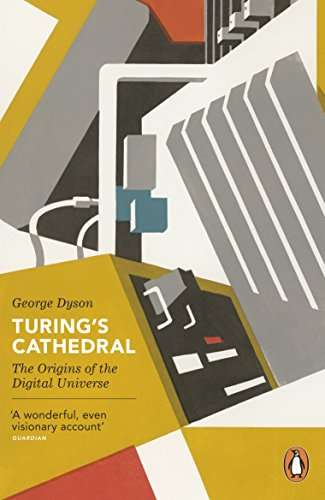
Turing's Cathedral: The Origins of the Digital Universe
Check my rate
| Main centres: | 1-3 business days |
| Regional areas: | 3-4 business days |
| Remote areas: | 3-5 business days |

| Main centres: | 1-3 business days |
| Regional areas: | 3-4 business days |
| Remote areas: | 3-5 business days |
Published by PENGUIN, 2013, softcover, illustrated, index, 310 pages, condition: as new.
In this revealing account of how the digital universe exploded in the aftermath of World War II, George Dyson illuminates the nature of digital computers, the lives of those who brought them into existence, and how code took over the world.
In the 1940s and '50s, a small group of men and women--led by John von Neumann--gathered in Princeton, New Jersey, to begin building one of the first computers to realize Alan Turing's vision of a Universal Machine. The codes unleashed within this embryonic, 5-kilobyte universe--less memory than is allocated to displaying a single icon on a computer screen today--broke the distinction between numbers that "mean" things and numbers that "do" things, and our universe would never be the same. "Turing's Cathedral "is the story of how the most constructive and most destructive of twentieth-century inventions--the digital computer and the hydrogen bomb--emerged at the same time.
"Despite the title, this book is not primarily about Alan Turing. It is really about the group of people at the Institute of Advanced Studies at Princeton. Much of the book focuses on John von Neumann, who spearheaded the effort to build some of the earliest electronic computers. These first computers were very unreliable--incorrect results were as likely due to faulty vacuum tubes as coding errors. In fact, circuits had to be designed to be robust to vacuum tubes that did not follow specs.
Quite a large chunk of the book--and the most fascinating--dealt with the types of mathematical and physical problems that the earliest computers could solve. In fact, that was the principal interest of von Neumann--learning what types of problems could be solved using computers. Here, Alan Turing and Kurt Godel played a large role in defining what sorts of problems might be solvable.
Among the problems that the earliest computers attacked was weather forecasting. In the late 1940's, there was much controversy about the feasibility of numerically computing forecasts in principle. Of course, weathermen wanted to continue to use their gut feelings to forecast the weather, while some scientists thought that, given sufficient spatial resolution, the weather could be forecast far in advance. It was not until later that people like Lorenz discovered that there are fundamental limits to how far in advance weather can be forecast.
The earliest computers were also used for developing the atomic bomb. Many aspects of the physics were not solvable using direct means. Simulations using a brand new numerical method called "Monte Carlo" were extremely significant for solving them. For this method to work, random numbers are required for initiating independent simulated trajectories. But random numbers were not easy to come by, so a special program helped to develop algorithms for computing them.
This book goes into considerable depth, in describing the people who developed and used the first computers at the institute. There are fascinating descriptions of the mathematical, physics, and biological puzzles that were attempted. I recommend the book highly, for those interested in the history of numerical computation."